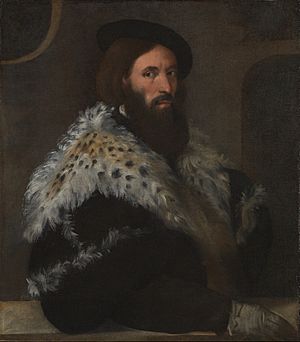Girolamo Fracastoro facts for kids

Girolamo Fracastoro (Latin: Hieronymus Fracastorius; born around 1476 or 1478 – died August 6, 1553) was an important Italian physician, poet, and scholar. He studied mathematics, geography, and astronomy. Fracastoro believed that everything was made of tiny, unseen particles. He also thought that scientists should look for real causes, not mysterious ones.
Contents
Girolamo Fracastoro's Life and Discoveries
Early Life and Education
Girolamo Fracastoro was born in Verona, which was part of the Republic of Venice at the time. He went to school in Padua. When he was only 19, he became a professor at the university.
A Respected Physician
Because he was such a good doctor, he was chosen to be the physician for the Council of Trent. The people of Padua put up a bronze statue to honor him. His hometown of Verona also remembered him with a marble statue. He lived and worked as a doctor in Verona for most of his life.
His Big Idea: Tiny Disease Particles
In 1546, Fracastoro suggested a new idea about how epidemic diseases spread. He thought they were caused by tiny, transferable particles, like "spores." He believed these "spores" could spread infection in a few ways:
- By direct contact with an infected person.
- By indirect contact, like touching clothes or other items an infected person used.
- Even without direct contact, over long distances.
It's important to know that when he talked about "spores," he might have meant chemicals, not tiny living things like bacteria or viruses.
Understanding How Diseases Spread
Fracastoro was one of the first to use the Latin word fomes. This word means "tinder" (like material used to start a fire). He used it to describe things that could carry disease. He wrote about this in his book De Contagione et Contagiosis Morbis (On Contagion and Contagious Diseases), published in 1546.
He explained: "I call fomites [from the Latin fomes] such things as clothes, linen, etc., which although not themselves corrupt, can nevertheless foster the essential seeds of the contagion and thus cause infection." His theory was very important for almost 300 years. Later, it was replaced by the more complete germ theory, which explains that diseases are caused by microorganisms.
Other Medical Discoveries
In his 1546 book De contagione, Fracastoro also gave the first description of typhus. His collected writings were first published in 1555.
Describing Animal Diseases
In 1546, Fracastoro described a disease that affected cattle. It caused a lot of problems for farmers near Verona, Italy. Today, we know this disease as foot-and-mouth disease (FMD). It's an animal illness that has been around for a very long time.
His Portrait by a Famous Artist
A painting of Fracastoro, which has been in the National Gallery since 1924, is now thought to be painted by the famous Italian artist Titian.
Honoring Fracastoro in Verona
His Statue in the City Square
A marble statue of Girolamo Fracastoro stands on a beautiful arch in the main Piazza dei Signori in Verona. This statue was made by the sculptor Danese Cattaneo and finished in 1559. It is near the monument to Dante Alighieri.
The Legend of the Stone Ball
On the base of the statue, there is an inscription. Fracastoro holds a stone ball in his right hand, which represents the world. A popular legend says that this ball will fall on the first truly honorable person who walks under the arch. Many people have walked under the arch over the centuries, but the ball has never fallen!
Fracastoro's Name in Space
A Crater on the Moon
The lunar crater called Fracastorius is named after him. This shows how important his contributions were.
His Ideas and Modern Science
The "Seeds of Disease" Theory
In the 1800s, scientists who studied bacteria looked at Fracastoro's writings. They saw his "seeds of disease" theory as an early idea that led to the modern germ theory. This theory states that specific tiny germs cause specific diseases.
Some of His Books
- Di Vino Temperatura (1534)
- Homocentricorum sive de Stellis, de Causis Criticorum Dierum Libellus (1535)
- Homocentrica (1538)
- Naugerius sive de Poetica Dialogus (around 1540)
- De Contagione et Contagiosis Morbis (1546)
See also
 In Spanish: Girolamo Fracastoro para niños
In Spanish: Girolamo Fracastoro para niños




